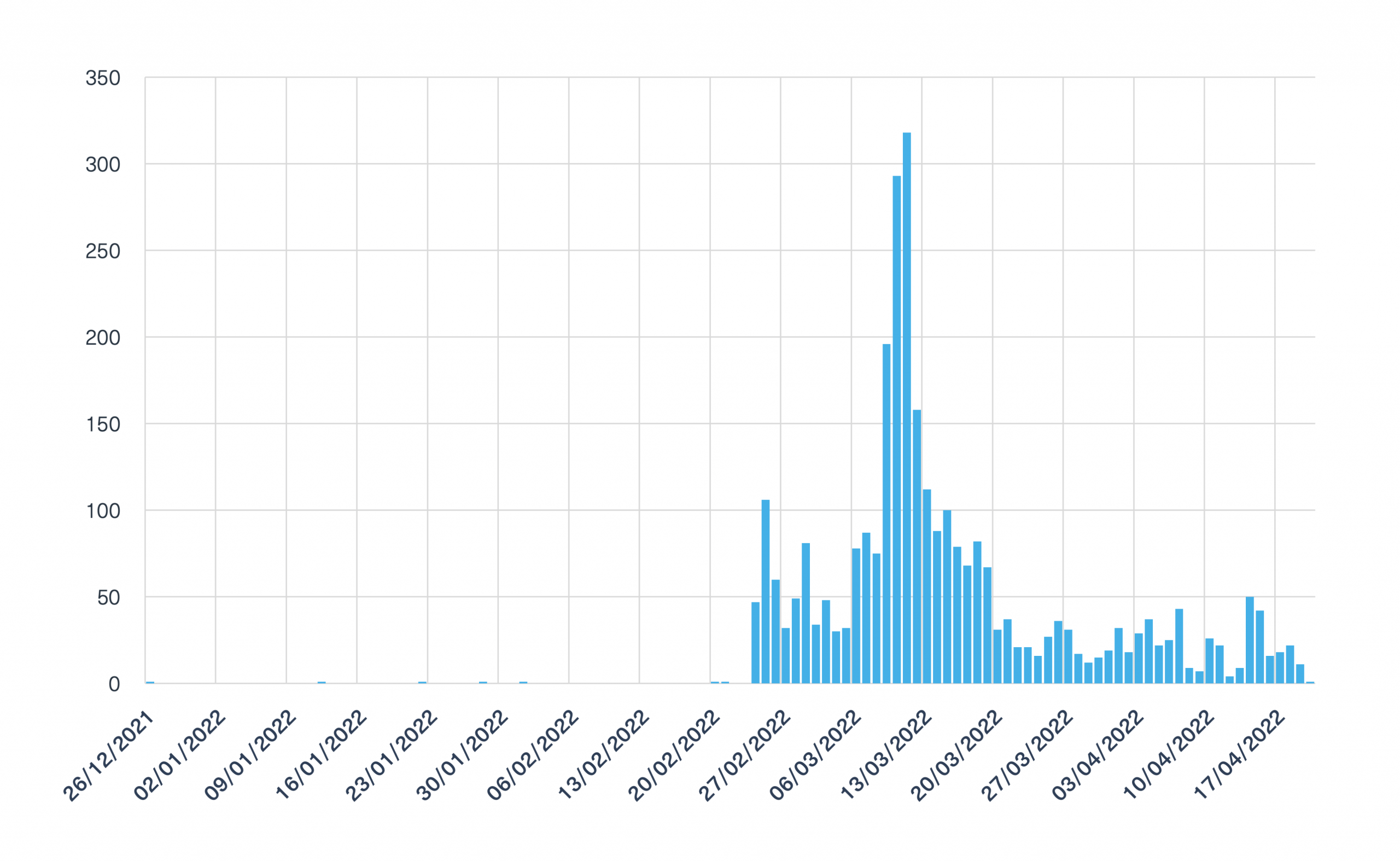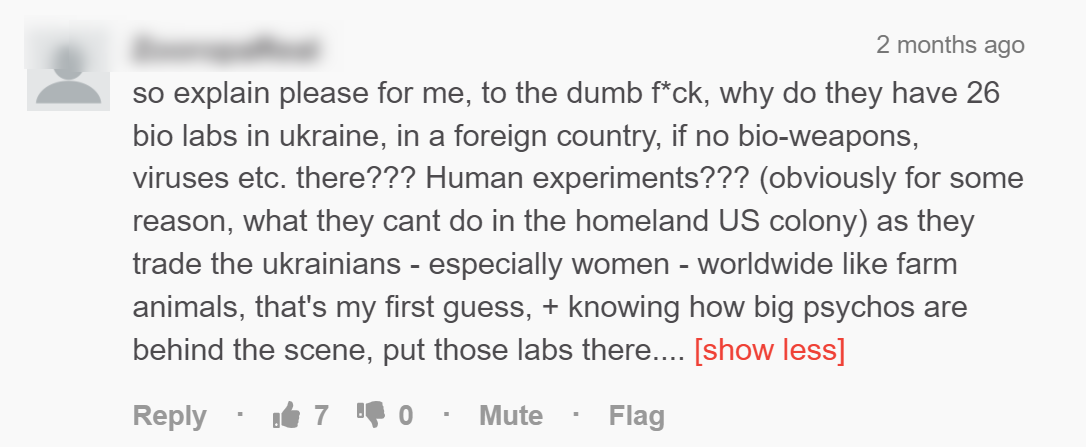Cyber Security News Aggregator
.Cyber Tzar
provide acyber security risk management
platform; including automated penetration tests and risk assesments culminating in a "cyber risk score" out of 1,000, just like a credit score.The Russia-Ukraine Information Warfare on Alternative Social Media Sites
published on 2022-04-27 07:43:35 UTC by Avishag YulevichContent:
After we covered the Russia-Ukraine war on the deep and dark web, it’s time to turn to another digital frontier that has remained under the radar for a while – alternative social media platforms. These sites play a crucial part in the disinformation war which crosses international borders and affects public opinion around the world.
Take for example the Ukraine bio lab conspiracy theory.
In late February, Pro-Russian media reported that Ukraine and the U.S. were developing biological weapons in labs across the country. The next day, English-speaking followers of the QAnon conspiracy theory repeated these accusations on social media sites. The Kremlin also used these claims to justify the invasion to Ukraine.
Despite the support of the Russian administration, these claims have since been rebuffed by several mainstream media outlets. But that did not stop this conspiracy theory from spiraling on alternative social media platforms.
Conspiracy theories on alternative social media platforms
The most prominent online spaces for conspiracy theorists in general, and QAnon followers in particular, are alternative social media platforms, chatting applications such as Telegram, and image boards. Because of the lack of restrictions on the type of content that can be shared, each of these platforms serves as a fertile ground for radical organizations, extremists content and incitement.
Over the past months, we have seen a rise in the amount of disinformation and inflammatory content posted by U.S. users on these platforms. Using our Cyber API, we took a closer look at the Ukraine bio labs conspiracy theory on alternative social media sites.
When did the Ukraine bio labs conspiracy theory start? And how did it evolve?
The story became public in late February, and it featured in global media in March, a few weeks into the war.
The chart below shows the volume of posts Webz.io crawled related to bioweapon labs in Ukraine starting from late December 2021.
By looking at the chart we can see a rough timeline of how the story unfolded on alternative social media platforms, which started with a rise in relevant mentions when the story first broke at the end of February. We are able to identify another increase in the number of mentions in early March when the story gained popularity in mainstream media.

The most interesting insight we can get from analyzing the number of mentions is that the spread of misinformation about the existence of bio labs in Ukraine started circling on alternative social media platforms before the beginning of the war. Although it is an important point to make – and illustrate, it is not surprising as misinformation usually begins and gains momentum in the margins of the internet. It takes time until it becomes public. By then, the disinformation is widely spread across alternative social media sites.
Using the data we crawled from these parts of the web, we are able to describe the life cycle of a conspiracy theory on alternative social media sites.
The Evolution of Conspiracy Theories on Alternative Social Media platforms
Stage #1: The spread of “alternative facts”
As mentioned before, alternative social media platforms are a thriving environment for conspiracy theorists. The lack of restrictions on the content and discussions held on these platforms enable many users to spread “alternative facts” and fake news. The first posts on a disputed subject would usually (but not always) be assertive and would voice a firm support of the claim, while presenting loose or no factual basis.
Below, you can see an example of a post from the imageboard ‘8kun’, published in late December of last year, months before the war began. In it, a user is claiming the U.S. has bio labs in Ukraine without presenting any proof:

Stage #2: Violent claims and call for action
Over time, as a conspiracy theory becomes more established and attracts more and more supporters, the content becomes even more extreme and at times even violent.
In the case of the bio labs conspiracy theory, by the time it became popular, we were able to find a lot of relevant mentions. In the next image you can see a post with more aggressive and serious accusations on the bio labs story:

Stage #3: Dissemination of wilder claims
Here you will usually find wilder claims which often spread disinformation. Some would evolve into a new conspiracy theory.
In the post below, which was posted as a comment to a video on an alternative social media platform last month, the user is arguing that the U.S. is performing human experiments and trafficking in Ukrainian women in the bio labs.

In the best case scenario, this post can lead to public outrage. At the worst, it can lead to a whole new conspiracy theory and possible physical threats or actions that risk human lives. This type of alarming posts are widespread on alternative social media platforms.
What’s next?
Using our dark web data feeds, we regularly see radical and inflammatory posts about the Russia-Ukraine war on alternative social media sites. In many posts, users claim to know some hidden, and deeming facts about either Russia or Ukraine, related to the war. As the task of differentiating between facts and fake news is becoming increasingly challenging, monitoring alternative social media platforms plays an important role not only in factchecking but also in mitigating the risks of misinformation.
Every day, new and baseless accusations begin on these sites. Only recently, a user published the next post, accusing the United Nations of committing war crimes in Ukraine:

Although the accusation was made without any basis or evidence, it can incite and lead to a new conspiracy theory, one that the United Nations should probably be aware of if not actively monitor. Because after all, these discussions and threats can cross from the web into the physical world at any given moment.
https://webz.io/dwp/the-russia-ukraine-information-warfare-on-alternative-social-media-sites/
Published: 2022 04 27 07:43:35
Received: 2022 12 04 14:47:03
Feed: Webz.io Dark Web Posts Web Intelligence
Source: Webz.io Dark Web Posts
Category: News
Topic: Web Intelligence
Views: 3
